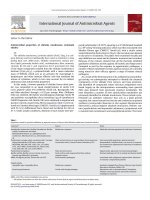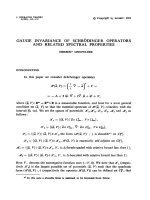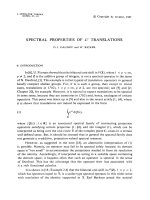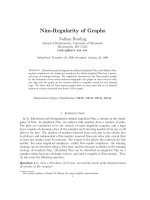Báo cáo toán học: "Ramseyan Properties of Graphs by Ermelinda DeLaVina" doc
Bạn đang xem bản rút gọn của tài liệu. Xem và tải ngay bản đầy đủ của tài liệu tại đây (81.29 KB, 5 trang )
Ramseyan Properties of Graphs
by
Ermelinda DeLaVina
Siemion Fajtlowicz
University of Houston, Houston, Texas 77024
Submitted: February 19, 1996; Accepted: August 28, 1996
Abstract.
Every graph of chromatic number k with more than k(r − 1)(b − 1) vertices has
a b-element independent set of vertices such that if any two of them are joined by
an edge then the chromatic number stays the same or a r-element independent set
of vertices such that joining any two of them by an edge increases the chromatic
number.
0. Introduction.
Let P be a class of graphs and let x and y be a pair of non-adjacent distinct
vertices of GP. For every graph consider a fixed coloring of all pairs {x, y} of
nonadjacent vertices - we color e = {x, y} blue if G + {e} belongs to P ,andred
- otherwise. A class, i.e., a property P of graphs will be called Ramseyan if large
graphs from P contain large monochromatic subgraphs. It is easy to see that P is
Ramseyan if and only if large enough graphs from P have large independent sets.
The necessity of this condition is obvious, and the sufficiency follows from Ramsey
theorem applied to the red-blue coloring of 2-element subsets of a large independent
set.
Given a Ramseyan class of graphs P we put P(r, b) to be the smallest integer
n such every graph from P with n or more elements contains a r-element red clique
or a b-element blue clique. Graphs of maximum order without this property will
be called P(r, b)−critical.
The goal of this paper is to prove the following
Theorem. If P is the class of all graphs of chromatic number k then P (r, b)=
1+k(r − 1)(b − 1).
Our theorem was conjectured by the first author who also proved it in some
cases and established all lower bounds. Examples of critical P (r, b) graphs are
disjoint unions of b − 1 copies of of complete k-partite graphs in which every part
has r − 1 vertices. Other critical graphs can be obtained by adding extra edges to
these examples but the description of all critical graphs may be quite difficult. The
first author characterized all such graphs for chromatic number 2 and 3, [D].
Before proving our theorem, we shall describe an interpretation extending the
usual illustration of Ramsey Theorem: a fraternity gives a get-acquainted party
subject to the rule that guests may be at will separated in rooms containing only
mutual strangers. If the fraternity has 3 rooms and 13 guests then either there are
three guests such that if any two of them will get acquainted then the party can
continue, or there are three guests such that if any two of them will get acquainted
then the party must end.
1. The Proof.
Let B(E)bethesetofblueedgesofG =(V,E)andletB(G) be the graph
(V,B(E)). The graph R(G) is defined similarly with respect to the red edges.
Lemma. If P is the class of all graphs of chromatic number k then R(E) is the
intersection of all equivalence relations corresponding to k-colorings of G.
Proof: Let π
c
be the equivalence relation corresponding to k-coloring c of G.If
{u, v} is a red edge then every k-coloring of G assigns to u and v the same color, i.e.
the set of edges of R(G) is contained in the intersection of all equivalence relations
of the form π
c
. Conversely if {u, v} is not red then either u is adjacent to v in which
case every k-coloration of G separates u from v, or the nonedge {u, v} is blue, in
whichcasethechromaticnumberofG + {u, v} is again k and thus there is at least
one k-coloration of G which separates u from v.ThusR(E) is the intersection of
all equivalence relations of the form π
c
,wherec is a k-coloring of G.
Consequently R(E) is an equivalence relation and we have
Corollary. R(G) is a union of disjoint cliques.
Proofofthetheorem:LetG be a graph of chromatic number k with more than
k(r − 1)(b − 1) vertices, and let I
j
, j =1 k, be a partition of vertices of G into
independent sets. By the lemma every component of R(G) is contained in one of
I
j
’s, and by the Corollary, each I
j
is partitioned into red cliques.
Since G has more than k(r − 1)(b − 1) vertices, one of the independent sets I
j
has more than (r − 1)(b − 1) vertices and thus it either contains a red clique with
r vertices or at least b disjoint red cliques. In the latter case let S be a selector of
the partition I
j
, i.e., let S meets each of the red cliques of I
j
at one vertex. S has
at least b vertices, and since it is independent and disjoint with R(E)itmustform
a blue clique, which proves the theorem.
2. Problems and Conjectures
So far we have studied very few Ramseyan properties, but in the case of triangle-
free class T , jointly with Professor Erdos we have shown that the numbers T (k,k)
are at most of order k
3
, and we think that similar results will hold true for K
n
-free
graphs. Specifically we conjecture that if P is the class of K
n
-free graphs then the
best lower bounds for P (r, b) can be obtained by taking disjoint unions of (b − 1)
many copies of maximal (with respect to the number of edges) critical Ramsey
graphs R(n, b).
Some Ramsey graphs are also critical with respect to our theorem. For example
the unique regular, 8-vertex graph containing no K
4
nor 3-element independent sets
is P(3, 2)-critical in the class of all 4-chromatic graphs.
The structure of the red graph is obvious by Corollary, but we do not know
which graphs can occur as blue graphs and what are the properties of graphs in
which the graph R(G) is empty. There are many examples of these red-reduced
graphs, and in a number of problems, it is enough to consider the factor-graph
G/R(E) whose vertices are equivalence classes of R(E), two being adjacent if and
only if they contain adjacent representatives. This operation may considerably
simplify some problems and it is extensively used in [D].
The operations of taking the blue and the red graphs are partial complements
of G. It would be interesting to determine the identities, and equational varieties of
unary algebras whose universe is class of at most countable graphs and operations
are those of taking the complement, the red and the blue graphs. The motivation
for this problem is that identities satisfied by a graph may give a considerable
insight into its structure. For example, B(G)=RR(G) if and only if G is complete
k-partite for some k.
The Dalmatian version of Graffiti made number of conjectures about operations
R and B (derived from the chromatic number) and we included a sample of them
in the first draft of this paper. Since then, most of these conjectures were settled in
[B] and two of them were also refuted by a referee of this paper. These conjectures
and a number of newer conjectures about triangle-free graphs can be found in [W].
References
[B] Bela Bollobas and Oliver Riordan, On Some Conjectures of Graffiti, preprint
1996.
[D] Ermelinda DeLaVina, PhD dissertation, in preparation.
[R] Ronald L. Graham, Bruce L. Rothschild and Joel H. Spencer, Ramsey
Theory, John Wiley and Sons, 1990.
[W] Written on the Wall, a list of conjectures of Graffiti.









